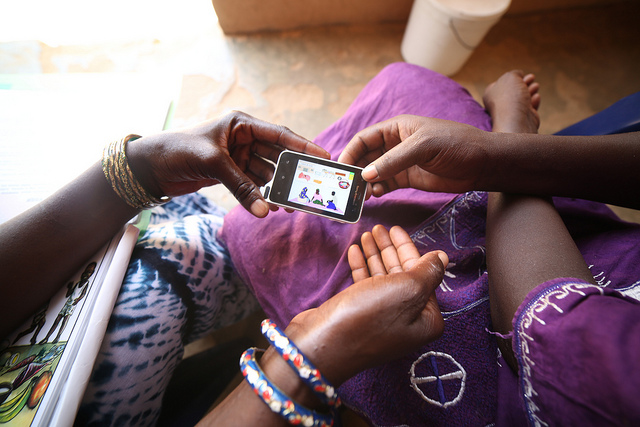“This technology will save millions of patients!” This was the elated comment from the head of a tuberculosis health facility in Lesotho, in response to my prototype of a mobile phone application. Last summer, I was exploring the value of machine learning in predicting patients’ default rates in HIV and tuberculosis treatment for a mobile health enterprise, Dimagi.
A few weeks later, as I joined the Harvard Kennedy School, the media exploded with information on health technology from other parts of the world: Google DeepMind announced its collaboration with London hospitals to leverage machine learning in cancer treatment; the Guardian described artificial intelligence and virtual reality as the future of healthcare; and the Economist’s “Schumpeter” published a piece on challenges in implementing and scaling technology-solutions in Africa.
So what’s the deal with health technology and the developing world?
Let’s start with some numbers. According to the World Health Organization, 1.7 billion people globally still lack access to essential medicines and basic health services — approximately the population of India and two USAs. 4.5 million children under the age of five still die annually, and HIV claims 1.2 million lives a year. Traditional development projects have made little headway in reaching those living at the most extreme levels of poverty. Infrastructure in remote villages and slums is scattered, resources are limited, and doctors and nurses are few and far between.
One small mobile for man. One giant leap for healthcare.
We clearly need a different approach that will help us close that delivery gap. In search for one, a team of my former colleagues at the World Bank Innovation Labs analyzed a few thousand innovations in service delivery to the poorest, the so-called “Bottom of the Pyramid.” The outcome was clear: social enterprises can be extremely effective in closing the delivery gap. Across the world, they innovate, leverage technology to lower costs, adapt to the local context, and master “last mile” delivery – often where the public sector most fails to deliver.
Dimagi, a World Bank grantee, is a good example. Incubated at the MIT Media Lab in 2002, Dimagi provides community health workers — local volunteers who travel to remote locations – with customized mobile-based applications that run on inexpensive phones. The mobile apps guide these frontline workers on how to provide basic diagnostics and counseling. Dimagi’s platform, CommCare has been used in over 50 countries, by partners ranging from Bill & Melinda Gates Foundation and USAID to Google, Microsoft, and GE.
Dimagi is not alone. There are countless examples of social enterprises effectively using health technology in low-income contexts. Some of them monitor disease outbreaks (Magpi). Others support diagnostics (MeraDoctor), pharmaceutical supply chain management (SMS for Life) or counterfeit medicine prevention (Sproxil). In India, Nigeria or Mexico you can even send an SMS to verify the authenticity of medicines you are buying.
Although success behind these organizations lies in careful customization, smart implementation, and an innovative business model, technology can and often does bring extraordinary benefits.
It can enable:
- Access to populations in remote areas,
- Cost reduction and economies of scale,
- HR management and deskilling – leveraging lower skills labor to deliver higher quality services,
- Closer feedback loops through better data tracking, and even
- Behavior change and treatment compliance support.
The World Bank team witnessed behavior change up close in India. Dimagi leverages social networks in counseling to increase treatment compliance. As a consequence, counseling sessions led by frontline workers using Dimagi were on average 2.6 times more likely to include the woman’s husband and 1.6 times more likely to include the mother-in-law.
Virtual Nurses and Drones?
At the same time, on the other side of the world, Silicon Valley companies lead another revolution – leveraging artificial intelligence (AI), machine learning, and big data for healthcare delivery. Since 2011, start-ups using machine learning in healthcare raised over $870M. A recent CB Insight article showcases 90 start-ups using such innovations in healthcare.
The question is: how applicable are these innovations for international development? There are already a few examples worth mentioning. AIME works with the governments in Brazil and the Philippines to predict the spread of the Zika or dengue viruses. The company leverages machine learning algorithms based on a few dozen variables, such as rain prediction, solar radiation, and wind direction to predict the moves of mosquito population. The start-up claims that it reaches 84% prediction accuracy three months in advance of the outbreak. Another start-up, Zipline, uses drone technology to deliver medical essentials to rural health facilities in Rwanda.
Let me be clear: Technology is not a silver bullet. As the Economist rightly pointed out, we need to keep working on improving policies and infrastructure to enable equity and quality of service delivery. Countries, like Rwanda, will still need roads, well-functioning hospitals and a better business environment. But the anecdotal evidence suggests that there is serious potential in leveraging the brightest minds and applying the best technology to save millions of lives.
And we must keep trying.

www.martamilkowska.com | @MartaMilkowska
Edited by Alen Amini
Photo Credit: Ericsson via Flickr

